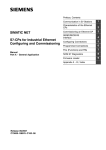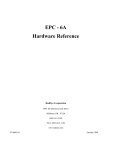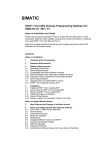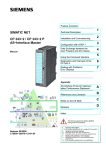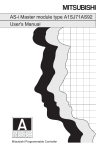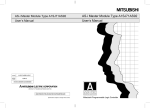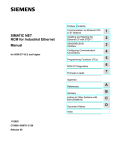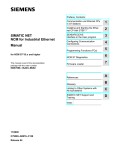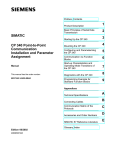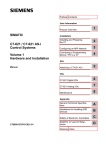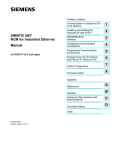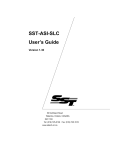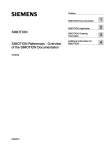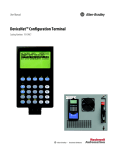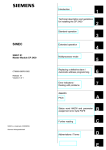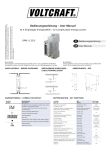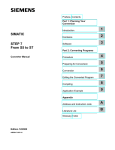Download AS-Interface Master Module CP 342-2
Transcript
SIMATIC NET AS-Interface Master Module CP 342-2 Volume 1 de 1 1 Introduction C79000-B8977-C101/01 2 Technical Description and Guidelines for Installing the CP 342-2 3 Standard Operation of the CP 342-2 4 Extended Operation of theCP 342-2 with FC "ASI_3422" 5 Replacing a Defective Slave / Automatic Address Programming 6 Error Indicators of the CP 342-2 / Dealing with Errors Appendix A AS-Interface Protocol Implementation Conformance Statement (PICS) B References C Abreviations / Terminology D Notes on the CE Approval C79000-G8976-C090 SIMATIC NET is a trademark from Siemens Siemens Aktiengesellschaft Release 01 B8976101/01 Contents CONTENTS 1 Introduction ....................................................................................................1-1 1.1 General Information............................................................................................................ 1-2 1.1.1 Overview of the Chapters .................................................................................................. 1-2 1.1.2 Symbols and Conventions Used in the Text....................................................................... 1-2 1.1.3 Requirements for Understanding the Manual ..................................................................... 1-2 1.1.4 Sample Programs/Readme File ......................................................................................... 1-3 1.1.5 Further Support and Hotline............................................................................................... 1-3 2 Technical Description and Guidelines for Installing the CP 342-2..............2-1 2.1 Overview of the Module ..................................................................................................... 2-2 2.1.1 Introduction........................................................................................................................ 2-2 2.1.2 Technical Data of the Module ............................................................................................ 2-4 2.1.3 Displays and Operator Controls on the CP 342-2............................................................... 2-5 2.1.4 Slots Permitted for the CP 342-2 in the SIMATIC AS-300 and in the ET 200M .................. 2-8 2.1.5 Types of Operation with the CP 342-2 ............................................................................... 2-8 3 Standard Operation of the CP 342-2 .............................................................3-1 3.1 Configuring the CP 342-2 for Standard Operation............................................................ 3-1 3.2 Addressing the CP 342-2 in the PLC ................................................................................. 3-3 3.3 How the PLC Addresses the Slaves on the AS-i Cable .................................................... 3-4 3.4 How the CP 342-2 Reacts to Diagnostic and Interrupt Events......................................... 3-7 3.4.1 Overview ........................................................................................................................... 3-7 3.4.2 Interrupt Events ................................................................................................................. 3-7 3.4.3 Sequence of Diagnostic Interrupt Processing..................................................................... 3-8 3.4.4 Reaction to Interrupts in Different CP Modes ..................................................................... 3-8 3.4.5 Local Data of the Diagnostic Organization Block (OB82).................................................... 3-9 3.4.6 Reading the Diagnostic Data Record DS 1 ........................................................................ 3-10 3.4.7 Programming Example ...................................................................................................... 3-11 4 Extended Operation of the CP 342-2 with FC “ASI_3422” ...........................4-1 4.1 Overview of the Functions ................................................................................................. 4-1 4.1.1 Calling the Function ........................................................................................................... 4-1 4.2 Interface for AS-i Commands............................................................................................. 4-6 4.2.1 Commands Supported by the CP 342-2............................................................................. 4-6 4.2.1.1 Set_Permanent_Parameter ............................................................................................ 4-7 4.2.1.2 Get_Permanent_Parameter ............................................................................................ 4-7 4.2.1.3 Write_Parameter ............................................................................................................ 4-8 4.2.1.4 Read_Parameter ............................................................................................................ 4-8 4.2.1.5 Store_Actual_Parameters ............................................................................................... 4-9 4.2.1.6 Set_Permanent_Configuration ........................................................................................ 4-9 4.2.1.7 Get_Permanent_Configuration ....................................................................................... 4-10 4.2.1.8 Store_Actual_Configuration ............................................................................................ 4-10 4.2.1.9 Read Actual Configuration Data...................................................................................... 4-11 4.2.1.10 Set_LPS ....................................................................................................................... 4-11 I-1 Contents B8976101/01 4.2.1.11 Set_Offline_Mode ......................................................................................................... 4-12 4.2.1.12 Select Autoprogramming............................................................................................... 4-13 4.2.1.13 Set_Operation_Mode.................................................................................................... 4-13 4.2.1.14 Change_Slave_Address................................................................................................ 4-14 4.2.1.15 Read Slave Status ........................................................................................................ 4-15 4.2.1.16 Read Lists and Flags (Get_LPS, Get_LAS, Get_LDS, Get_Flags) ............................... 4-16 4.2.1.17 Read Total Configuration .............................................................................................. 4-18 4.2.1.18 Configuring the Total System ........................................................................................ 4-20 4.2.1.19 Write Parameter List..................................................................................................... 4-23 4.2.1.20 Read Parameter Echo List ............................................................................................ 4-24 4.2.1.21 Read Version ID ........................................................................................................... 4-25 4.2.1.22 Read Slave Status and Delete ...................................................................................... 4-26 4.2.1.23 Read Slave ID............................................................................................................... 4-27 4.2.1.24 Read Slave I/O ............................................................................................................. 4-27 5 Replacing a Defective Slave / Automatic Address Programming ...............5-1 6 Error Indicators on the CP 342-2 / Dealing withErrors ................................6-1 1 Introduction ....................................................................................................1-1 1.1 General Information............................................................................................................ 1-2 1.1.1 Overview of the Chapters .................................................................................................. 1-2 1.1.2 Symbols and Conventions Used in the Text....................................................................... 1-2 1.1.3 Requirements for Understanding the Manual ..................................................................... 1-2 1.1.4 Sample Programs/Readme File ......................................................................................... 1-3 1.1.5 Further Support and Hotline............................................................................................... 1-3 2 Technical Description and Guidelines for Installing the CP 342-2..............2-1 2.1 Overview of the Module ..................................................................................................... 2-2 2.1.1 Introduction........................................................................................................................ 2-2 2.1.2 Technical Data of the Module ............................................................................................ 2-4 2.1.3 Displays and Operator Controls on the CP 342-2............................................................... 2-5 2.1.4 Slots Permitted for the CP 342-2 in the SIMATIC AS-300 and in the ET 200M .................. 2-8 2.1.5 Types of Operation with the CP 342-2 ............................................................................... 2-8 3 Standard Operation of the CP 342-2 .............................................................3-1 3.1 Configuring the CP 342-2 for Standard Operation............................................................ 3-1 3.2 Addressing the CP 342-2 in the PLC ................................................................................. 3-3 3.3 How the PLC Addresses the Slaves on the AS-i Cable .................................................... 3-4 3.4 How the CP 342-2 Reacts to Diagnostic and Interrupt Events......................................... 3-7 3.4.1 Overview ........................................................................................................................... 3-7 3.4.2 Interrupt Events ................................................................................................................. 3-7 3.4.3 Sequence of Diagnostic Interrupt Processing..................................................................... 3-8 3.4.4 Reaction to Interrupts in Different CP Modes ..................................................................... 3-8 3.4.5 Local Data of the Diagnostic Organization Block (OB82).................................................... 3-9 3.4.6 Reading the Diagnostic Data Record DS 1 ........................................................................ 3-10 3.4.7 Programming Example ...................................................................................................... 3-11 4 Extended Operation of the CP 342-2 with FC “ASI_3422” ...........................4-1 I-2 B8976101/01 Contents 4.1 Overview of the Functions ................................................................................................. 4-1 4.1.1 Calling the Function ........................................................................................................... 4-1 4.2 Interface for AS-i Commands............................................................................................. 4-6 4.2.1 Commands Supported by the CP 342-2............................................................................. 4-6 5 Replacing a Defective Slave / Automatic Address Programming ...............5-1 6 Error Indicators on the CP 342-2 / Dealing withErrors ................................6-1 I-3 B8976101/01 1 AS-i Master Module CP 342-2 Introduction This manual describes the functions of the CP 342-2 and how to program the module. To understand this manual, it is assumed that you have read the section of the manual entitled “AS-Interface Introduction and Basic Information”. We recommend the following procedure when ... ...You want an overall picture of the ASinterface. ´ First read the manual “AS-Interface Introduction and Basic Information”. This contains general information about the AS-interface, abbreviated to AS-i in the remainder of this manual. ...You want to know how to program the CP 342-2. ´ Read Chapter 1 Section 1.5 “Master Mode” in the manual “Introduction and Basic Information”. In addition to this, you should also read Chapters 3 and 4 in this manual. ...You want to start up the PLC master module CP 342-2. ´ Chapter 2 Section 2.1 ‘Overview of the Module’ and Chapter 3 ‘Standard Operation of the CP 342-2’ contain the information you require. ...You want to create a PLC program for standard applications. ´ Chapter 3 contains all the information you require for standard operation. ...You require additional information about extended operation. ´ Refer to Chapter 4 for the required information. 1-1 AS-i Master Module CP 342-2 1.1 B8976101/01 General Information 1.1.1 Overview of the Chapters Chapter 1 Introduction This chapter contains general information about the layout and use of the manual. Chapter 2 Technical Description and Guidelines for Installing the CP 342-2 This chapter provides an overview of the modes, installation and startup and the display and operating elements of the CP 342-2. Chapter 3 Standard Operation of the CP 342-2 Chapter 3 describes standard operation of the module which is particularly straightforward and easy to use. This mode allows direct access to the inputs and outputs of the AS-i slaves just like digital I/O modules of the SIMATIC PLC. Chapter 4 Extended Operation of the CP 342-2 with FC “ASI_3422” Chapter 4 describes the extended mode of the CP 342-2 that requires FC “ASI_3422” in the control program. When using this mode, it is, for example, possible to assign parameters to the AS-i slaves or modify the slave addresses by programming the changes in an S7 program. Chapter 5 Replacing a Defective Slave/Automatic Address Programming Chapter 5 explains how you can replace a defective AS-i slave simply and easily. Chapter 6 Error Indicators on the CP 342-2/Dealing With Problems This chapter lists and explains the possible error and fault indications on the CP 342-2 and describes ways to eliminate problems. 1.1.2 Symbols and Conventions Used in the Text General symbols in the text: This symbol indicates an action for you to perform. This symbol highlights special features or dangers. 1.1.3 Requirements for Understanding the Manual To fully understand the manual, you should already be familiar with the following: ± Programming in STEP 7 ± The ‘AS-Interface Introduction and Basic Information’ manual. 1-2 B8976101/01 1.1.4 AS-i Master Module CP 342-2 Sample Programs/Readme File The floppy disk accompanying this manual contains sample programs in the directory \CP3422\English that provide you with instructions and help when programming the CP 342-2. These sample programs are explained. The readme.txt file contains up-to-date information and explains any restrictions that apply to the use of the CP 342-2. 1.1.5 ± Further Support and Hotline If you have questions about using the software and cannot find the answers to your problem in the manuals or in the on-line help, please contact your local representative or distributor. You library can obtain the addresses as follows: in the catalog IK10, in CompuServe (go autforum area SINEC) and on the Internet (http://www.aut.siemens.de). Ö Our hotline is also available for questions: Tel. +49(911) 895–7000 (Fax -7001) ± Our custom support on the Internet provides answers to common questions. Under FAQ (Frequently Asked Questions), you will find information about our range of products. The AUT home page is the worldwide web under the following address: http://www.aut.siemens.de. 1-3 AS-i Master Module CP 342-2 B8976101/01 1-4 B8976101/01 2 AS-i Master Module CP 342-2 Technical Description and Guidelines for Installing the CP 342-2 This chapter outlines the basic functions of the CP 342-2 master module and explains how the module is installed and started up. You will learn the following: ± Which PLC systems can be operated using the CP 342-2 on the AS-interface. ± How to install the CP 342-2. ± Which modes are supported by the CP 342-2. Make sure that the S7-300 CPUs you are using are the latest versions or upgrade them to the latest version, otherwise correct operation in conjunction with the CP 342-2 cannot be guaranteed. The versions of the S7-300 CPUs must be the following or higher: CPU 312 CPU 313 CPU 314 CPU 315 CPU 315-2 DP Version 4 Version 2 Version 5 Version 2 Version 2 When installing the module, please adhere to the, guidelines for handling electrostatically sensitive devices and the instructions in the corresponding S7-300 manual. 2-1 AS-i Master Module CP 342-2 2.1 B8976101/01 Overview of the Module 2.1.1 Introduction The CP 342-2 module can be operated in the programmable logic controllers (PLCs) of the S7-300 range. It allows the connection of one AS-i chain to the programmable logic controllers mentioned above. CP 342-2 S7-300 Passive AS-i user module (without slave ASIC) AS-i cable AS-i power supply unit Active AS-i user module (with slave ASIC) (4 x slave) Binary sensor and actuator without slave ASIC Binary sensors and actuators with slave ASIC = Slave ASIC Active or passive AS-I module Branch of the AS-i cable Figure 2-1 Using the Master Module CP 342-2 in the S7-300 2-2 Actuator or sensor with direct connection B8976101/01 AS-i Master Module CP 342-2 PROFIBUS CP 342-2 ET 200M (IM 153) Passive AS-interface module (without slave ASIC) Active AS- interface module (with slave ASIC) AS-i cable AS-i power unit (4 x Slave) Binary sensors and actuators with slave ASIC = Slave ASIC Binary sensors and actuators without slave ASIC Active or passive AS-interface module Actuator or sensor with direct connection Branch of the AS-i cable Figure 2-2 Distributed Use of the Master Module CP 342-2 in the ET 200M Components Supplied The product CP 342-2 includes the following components: 1. The CP 342-2 module 2. Bus connector 3. Labeling material 4. Product information The STEP 7 block FC “ASI_3422” required for extended operation with the CP 342-2 is supplied with this manual. The 20-pin front connector for connecting the AS-i cable is not supplied with the CP 342-2. For the order number and other information, refer to the SIMATIC S7 catalog ST 70. 2-3 AS-i Master Module CP 342-2 2.1.2 B8976101/01 Technical Data of the Module The table below outlines the most important technical data of the CP 342-2 module: Bus cycle time 5 ms with 31 slaves Configuration By switches on the front panel or with FC “ASI_3422” AS-i profile supported Without FC “ASI_3422”: M0 With FC “ASI_3422”: M1 Connection to the AS-i cable Via the S7-300 front connector with screw contact (20 pin) Current load capability from connection 17 to 19 or from connection 18 to 20 maximum 4 A Address range 16 input bytes and 16 output bytes in the analog area of the S7-300 Power supply SIMATIC back plane bus Current consumption from the AS-i cable Power supply from the AS-i cable Power consumption from DC 5 V DC 5 V Max. 100 mA According to the AS-i specification Max. 200 mA Permitted environmental conditions • • • Operating temperature 0 to 60°C Transport and storage temperature -40°C to +70°C Relative humidity Max. 95% at +25°C Design • • • Module format S7-300U design, single width Dimensions (W x H x D) in mm 40 x 125 x 115 Weight Approx. 200 g Table 2-1 Technical Data 2-4 B8976101/01 2.1.3 AS-i Master Module CP 342-2 Displays and Operator Controls on the CP 342-2 The following diagram shows the front panel of the CP 342-2 with displays and operator controls. The front connector for connecting the AS-i cable is below the cover on the front of the CP 342-2. CP 342-2 SF RUN APF CER AUP CM 30+ 20+ 10+ SET 9 8 7 6 5 4 3 2 17 18 19 AS-i+ (brown) AS-i- (blue) 1 0 20 , . Connections 17, 19 and 18, 20 are jumpered internally in the CP Figure 2-3 Front Connector and Labeling of the CP 342-2 The CP has internal connections for two AS-i cables that are jumpered internally in the CP. This makes it possible to “loop” the CP 342-2 into the AS-i cable. The maximum load of the connection contacts is 4 A. If this value is exceeded on the AS-i cable, the CP 342-2 must not be “looped” into the AS-i cable but must be connected by a tap line. (Only one connection of the CP 342-2 used.) 2-5 AS-i Master Module CP 342-2 B8976101/01 Meaning of the displays and control elements: SF System fault. The LED is lit in the following situations: ± When the CP 342-2 is in the protected mode and there is an AS-i configuration error (for example slave failure). ± The CP has detected an internal fault (for example EEPROM defective). ± When the CP cannot make the mode change requested by the switch setting (for example a slave with address 0 exists). RUN Indicates that the CP has started up correctly. APF AS-i Power Fail. Indicates that the voltage supplied by the AS-i power unit on the AS-i cable is too low or has failed. CER Configuration Error. This LED indicates whether the slave configuration detected on the AS-i cable matches the configuration stored on the CP (LPS). If they do not match, the CER display is lit. The CER display is lit in the following situations: ± When a configured AS-I slave does not exist on the AS-I cable (e.g. fault on the slave). ± When a slave exists on the AS-I cable but has not been configured. ± When a connected slave has different configuration data (I/O configuration, ID code) from those configured on the CP. ± When the CP is in the off-line phase. AUP Autoprog available. This indicates that the address of a slave can be programmed automatically. Automatic address programming makes the replacement of a defective slave on the AS-I cable much easier. (see Chapter 5). CM Configuration Mode. The mode is displayed here. Display on: Display off: Configuration mode Protected mode The configuration mode is only required when installing the CP 342-2. In the configuration mode, the CP 342-2 activates all connected slaves and exchanges data with them. For more information about the configuration mode/protected mode, refer to Section. 3.1. SET Button The SET button is required for configuring the CP 342-2 in the standard mode. The button is only activated when the PLC is in the STOP mode. ± If the CP is in the configuration mode (CM lamp lit) the CP is automatically configured if you press the button. The configuration takes place in the following steps: 1. The existing slave configuration signaled by the display of active slaves is stored permanently by the CP as the desired configuration. 2. The CP then changes to the protected mode. 2-6 B8976101/01 AS-i Master Module CP 342-2 ± If the CP is in the protected mode (CM lamp not lit), pressing the button changes the CP to the configuration mode. For more detailed information about configuring the CP 342-2, refer to Section 3.1. The button must be pressed for at least 0.5 seconds to allow the mode to be changed. Display of the Active Slaves The active slaves are indicated by LEDs 0 to 9 and the LEDs 10+, 20+ and 30+. The display of the activated slaves is in groups of 10. These are switched over at regular intervals. The LEDs labeled 10+, 20+, 30+ indicate which of the groups of 10 slaves are currently indicated by the LEDs 0 - 9. Failed or existing but unconfigured slaves are indicated in the protected mode by the LED flashing. Example 1: Indicates that the slaves with addresses 1, 2 and 5 are activated. Example 2: Indicates that the slaves with addresses 20, 21 and 22 are activated. Figure 2-4 Display of the Active AS-i Slaves on the Front Panel of the CP 2-7 AS-i Master Module CP 342-2 2.1.4 B8976101/01 Slots Permitted for the CP 342-2 in the SIMATIC AS-300 and in the ET 200M In principle, the CP can be inserted in all the slots for I/O modules in the S7-300 and ET 200M racks. There are, however restrictions involving the CPU and the power supply in terms of the following: ± The extendibility with several racks (multi-tier configuration of the PLC only with the CPU 314 and higher), ± The electrical design, in other words the entire current consumption from the S7 backplane bus. For more detailed information on these topics, please refer to the corresponding system manuals. 2.1.5 Types of Operation with the CP 342-2 With the CP 342-2 module, 2 types of operation are possible: • Standard operation • Extended operation (with FC “ASI_3422”) The difference between the 2 types of operation is as follows: Standard Operation In this type of operation, the CP 342-2 operates as a conventional analog input/output module. For each slave on the AS-I cable four input and four output bits are reserved on the controller. In standard operation, no commands or special parameters can be transferred to the slaves on the AS-I cable. This type of operation corresponds to the profile M0 of the AS-I master specification Extended Operation (with FC “ASI_3422”) In extended operation, the PLC programmer has the complete range of functions available in the AS-i system. In particular, the AS-i master calls (for example to assign parameters to slaves) are available. This type of operation corresponds to the profile M1 of the AS-i master specification. For extended operation, in addition to the CP 342-2, the function “ASI_3422” is also required and is supplied with this manual. 2-8 B8976101/01 3 AS-i Master Module CP 342-2 Standard Operation of the CP 342-2 Standard operation represents the most common and at the same time simplest use of the CP 342-2. It allows direct access to the inputs and outputs of the slave (e.g. bus modules) just as with analog I/O modules of the SIMATIC PLC. This type of operation is available immediately after plugging in the module; no FC is required. 3.1 Configuring the CP 342-2 for Standard Operation The CP 342-2 is capable of two operating modes, the configuration mode and the protected mode. When supplied, the CP 342-2 is set for the configuration mode indicated by the CM LED being lit. ± Configuration Mode: The configuration mode is used to install and start up an AS-i installation. In the configuration mode, the CP 342-2 can exchange data with every slave connected to the AS-i cable. Newly added slaves are detected immediately by the master and included in the cyclic data exchange. After testing the PLC program, the CP 342-2 can be switched to the protected mode when the PLC CPU is in the STOP mode by pressing the SET button. ± Protected Mode: If the CP 342-2 is in the protected mode, it only exchanges data with the slaves that are “configured”. “Configured” in this sense means that the slave address saved on the CP and the configuration data stored on the CP match the values of a slave. Configuration of the CP 342-2 during installation and start-up of the AS-i network The following situation is assumed: ± The connected AS-i slaves are supplied with addresses (address programming device). ± The AS-i bus is complete, i.e. with the AS-i power supply unit in operation and the slaves are connected to the AS-i cable. To configure the CP 342-2 in standard operation while installing the AS-i network, follow the steps outlined below: Switch the PLC to the STOP mode Change the CP 342-2 to the configuration mode, (press the button on the CP 342-2 while the PLC is in the STOP mode; the CM lamp lights up. If the CP is already in the configuration mode (as supplied), this step can be omitted. Switch the PLC to RUN and test your program. Note: In the configuration mode, you can also add or remove slaves from the AS-i cable. Newly added slaves are activated immediately by the CP 342-2. On completion of the installation of the AS-i slave, switch the PLC to the STOP mode. Now press the SET button of the CP 342-2. The CP adopts the configuration indicated by the active slaves as the desired configuration and switches to the protected mode. In the protected mode, the “CM” LED is switched off. Switch the PLC to RUN. The installation of the CP is then completed. 3-1 AS-i Master Module CP 342-2 B8976101/01 Simplified Configuration Once you are certain that all the slaves on the AS-i cable are functioning correctly (e.g. when a CP 342-2 is replaced), the CP 342-2 can be started up as follows: Switch the PLC to the STOP mode. Change the CP 342-2 to the configuration mode, (press the SET button; the CM indicator lights up. If the CP is already in the configuration mode (as supplied), this step can be omitted. Now press the “SET” button again on the CP 342-2. The CP then adopts the configuration indicated by the active slaves as the desired configuration and switches to the protected mode. In the protected mode, the “CM” LED is switched off. Switch the PLC to RUN. The CP is then started up. 3-2 B8976101/01 3.2 AS-i Master Module CP 342-2 Addressing the CP 342-2 in the PLC The CP 342-2 occupies 16 input bytes and 16 output bytes in the I/O address area of the S7 programmable logic controller (analog area of the PLC). The start address of this address area is decided by the slot of the CP 342-2. Of the 16 byte address area of the CP 342-2, 31 x 4 bits are occupied by the AS-i slave data. The remaining 4 bits are reserved for later applications. The start address n of this address area is decided by the slot of the CP 342-2, as follows: Rack 0 Module Slot number PS 1 CPU IM 2 3 CP 4 CP 5 CP 6 CP 7 CP 8 CP 9 CP 10 CP 11 Start address 1 2 3 256 272 288 304 320 336 352 368 IM 3 CP CP CP CP CP CP CP CP 4 5 6 7 8 9 10 11 384 400 416 432 448 464 480 496 Module IM CP Slot number Start address 3 4 5 6 7 8 9 10 11 512 528 544 560 576 592 608 624 IM 3 CP 4 Rack 1 Module Slot number Start address Rack 2 CP CP CP CP CP CP CP Rack 3 Module Slot number Start address CP 5 CP 6 CP 7 CP 8 CP 9 CP 10 CP 11 640 656 672 688 704 720 736 752 In the CPU 315-2 DP, the slot-oriented addressing can be changed using STEP 7 configuration. 3-3 AS-i Master Module CP 342-2 3.3 B8976101/01 How the PLC Addresses the Slaves on the AS-i Cable Each station (slave) on the AS-i cable is assigned 4 bits (a nibble) by the CP 342-2. The PLC can write (slave output data) and read (slave input data) this nibble. This allows bi-directional slaves to be addressed. The first four input bytes (first nibble) are reserved for the use of FC “ASI_3422”. If no FC is used, the first four input bits change approximately every 2.5 seconds between the values 8H and EH. The first four output bits (first nibble) have no significance for the CP 342-2. Assignment: I/O byte number Bit 7-4 Bit 3-0 n+0 reserved Slave 1 n+1 Slave 2 Slave 3 n+2 Slave 4 Slave 5 n+3 Slave 6 Slave 7 n+4 Slave 8 Slave 9 n+5 Slave 10 Slave 11 n+6 Slave 12 Slave 13 n+7 Slave 14 Slave 15 n+8 Slave 16 Slave 17 n+9 Slave 18 Slave 19 n+10 Slave 20 Slave 21 n+11 Slave 22 Slave 23 n+12 Slave 24 Slave 25 n+13 Slave 26 Slave 27 n+14 Slave 28 Slave 29 n+15 Slave 30 Bit 3 Bit 3 | Bit 2 | Bit 2 | Bit 1 | Bit 0 Slave 31 | Bit 1 | Bit 0 Bit 3 | Bit 2 | Bit 1 | Bit 0 n = Start address The table illustrates the assignment of the CP 342-2 interface (n is the start address of the I/O address area occupied by the CP 342-2). The table shows the assignment of the slave I/O bit to the I/O byte of the PLC. 3-4 B8976101/01 AS-i Master Module CP 342-2 Example of the assignment of connections If AS-i modules are used as slaves on the AS-i cable, each of the connections to the AS-i module corresponds to exactly 1 bit in the PLC. The following example illustrates the assignment of two AS-i modules with addresses 2 and 3. Slave 2 Slave 3 PLC bit 7 6 5 4 3 2 1 0 Connection to AS-i module 4 3 2 1 4 3 2 1 Table 3-2 PLC I/O bits Assignment of the Connections to the AS-i Module Explanation: Slave 2 corresponds, in this case, to the AS-i module with address 2 Slave 3 corresponds to the AS-i module with address 3. Example of the PLC Addressing a Slave Just as with standard modules of the analog I/Os, the S7-300 can access the inputs and outputs of the AS-i slaves. The following example illustrates this procedure: Example: CP 342-2 with start address n = 256 Start address 256 256 257 258 . . . S7 - 300 S lav e 1 reserved Bit 3 Slave 2 Bit 3 Bit 2 Bit 1 Bit 0 Bit 2 Bit 1 Bit 0 Bit 3 Bit 3 Bit 2 Bit 1 Bit 0 Bit Bit33 7 6 5 4 3 I/O byte no. Bit 0 Bit 1 Bit 0 Bit 1 Bit 0 Slave S l av e 31 Bit 31BitBit22 Bit 11 Bit Bit00 Bit 2 Slave 5 Slave 30 271 Bit 1 Bit 3 Slave 4 Bit 3 Bit 2 Slave 3 Bit 2 2 1 0 I/O bit no. A S-i slav es Slave no. 2 Slave no. 3 Slave no. 4 I/O code= 9H I/O code= EH I/O code= 8H Slave no. 31 ( AS-I module ) I/O code= 0H Bit 3 Bit 2 Bit 1 Bit 0 Bit 3 Bit 2 Bit 1 Bit 0 Bit 3 Bit 2 Bit 1 Bit 0 Bit 3 Bit 2 Bit 1 Bit 0 Connection Used al as usgang output be u used as als Ausgang output ben Connection Used as input 1 A S - i m o du le 2 A S-i m odul e used as output Connection bidirectional Connection Figure 3-1 Mapping the Slave Addresses on the I/O Addresses 3-5 3 A S - i m o du l e 4 A S -i m o du l e AS-i Master Module CP 342-2 B8976101/01 Access to the AS-i User Data The bits of the AS-i slaves are accessed using the following S7 load and transfer instructions: L L T T PIW PID PQW PQD X X X X X stands for the byte address in the CP 342-2. For system-internal reasons, only word or double word access to even byte addresses is possible. The byte transfer instructions L PIB X or T PQB X are not permitted in conjunction with the CP 342-2. Example: Correct: Wrong: Wrong: L PIW 260 T PQB 260 L PIW 257 If you require bit access to slave data, you can follow the procedure shown in the sample program below for a CP with start address 256: OPEN DB 20 //Open a data block // // 1.) At program start: - Read in “pseudo PII” of the // inputs (copy the input data of the CP 342-2 to a data block) // // L PID 256 T DBD 0 L PID 260 T DBD 4 L PID 264 T DBD 8 L PID 268 T DBD 12 . . // // 2.) In the program:- evaluate single “input bits” // - Set/reset single // “output bits” A DBX 5.4 S DBX 22.3 R DBX 28.0 . . // 3.) At program end: - Output pseudo PIQ of the outputs // (copy data words to the // output data of the CP342-2) L DBD 16 T PQD 256 L DBD 20 T PQD 260 L DBD 24 T PQD 264 L DBD 28 T PQD 268 3-6 B8976101/01 3.4 AS-i Master Module CP 342-2 How the CP 342-2 Reacts to Diagnostic and Interrupt Events 3.4.1 Overview If the CP 342-2 recognizes an external or internal fault during operation (AS-i slave failure, EEPROM fault on the CP, ...), it signals this by triggering a diagnostic interrupt on the S7 peripheral bus. The S7 CPU then interrupts the cyclic user program (OB1), enters the event as “module fault” in the system diagnostic buffer and then reacts as follows: ± If the user has not programmed a corresponding interrupt OB (OB82), the PLC CPU changes to the STOP mode! ± If the user has programmed OB82, this is started by the PLC operating system. The local data of OB82 already contain certain diagnostic information for the user (which module triggered the interrupt? What type of error has occurred? ...). The application program can provide more detailed diagnostic information (which slave has failed? ...) by reading the diagnostic data record DS 1 using system function SFC 59 (“RD_REC”). On completion of OB82, the PLC resumes the cyclic program (OB1) at the point at which it was interrupted. It is not possible to program OB82 on the CPU 312, in other words if a diagnostic interrupt occurs, the CPU changes to the STOP mode. 3.4.2 Interrupt Events The CP 342-2 distinguishes between interrupt events entering and leaving the state. If the occurrence of an interrupt event leads to an error-free status (AS-i-CONFIG_OK=TRUE and no CP-internal error), a diagnostic interrupt leaving state is triggered (in OB82: bit OB82_MDL_DEFECT = 0). All other interrupt events result in a diagnostic interrupt entering state (bit OB82_MDL_DEFECT = 1). The events that can cause the CP 342-2 to trigger a diagnostic interrupt are listed below: CP-external interrupt events: ± All changes to the AS-i slave configuration in the protected mode. ± AS-i power fail in the protected mode. CP-internal interrupt events: ± EEPROM error CP-internal interrupt events are always events entering the state. After a CP-internal interrupt event, the group error bit remains set to = TRUE. This is only reset after a complete restart on the S7-300. 3-7 AS-i Master Module CP 342-2 3.4.3 B8976101/01 Sequence of Diagnostic Interrupt Processing If the CP 342-2 detects an interrupt event, it triggers a diagnostic interrupt. The PLC CPU finds the source of the interrupt and reads data record 0 on the CP. Following this, it interrupts the cyclic user program and reacts as follows: ± If OB82 is not programmed, the PLC CPU changes to STOP as default. ± If organization block OB82 is programmed, it is started. In the local data area of OB82, local data bytes 8 to 11 contain data record 0. It is possible to read data record 1 that contains the so-called delta list in OB82 using an SFC call (SFC 59 “RD_REC”), however this is not mandatory. ± On completion of OB82, the PLC CPU acknowledges the diagnostic interrupt in the CP 342-2. If interrupt events occur in a status in which the event cannot be signaled by triggering a diagnostic interrupt (for example when the PLC is in the STOP mode or when an older diagnostic interrupt has not yet been acknowledged) the CP 342-2 reacts as follows: 3.4.4 ± Once a diagnostic interrupt can be triggered again, and if the current total CP configuration (in other words the AS-i slave configuration and CP-internal, interrupt relevant state) is not identical to the configuration signaled previously by the diagnostic interrupt, a diagnostic interrupt is generated with the current configuration information. ± When it is possible to trigger a diagnostic interrupt again, and if at this time the current total CP configuration is the same as the configuration signaled earlier by the diagnostic interrupt, no diagnostic interrupt is generated. Brief slave failures (for example a bad contact) may therefore not be signaled. Reaction to Interrupts in Different CP Modes The CP 342-2 generates diagnostic interrupts triggered by external interrupt events only in the protected mode and not in the configuration mode. When the PLC CPU changes to STOP, the external and internal interrupt history is reset, in other words bit OB82_MDL_DEFECT and all other error bits in data record 0 are reset. When the CP changes from the protected mode to the configuration mode, the external interrupt history is reset. When the CP changes from the configuration mode to the protected mode and there is a configuration error pending, this is signaled by a diagnostic interrupt. If it is temporarily not possible to generate the diagnostic interrupt (for example when the PLC is in the STOP mode), a diagnostic interrupt is generated at the next possible time if there is still an error. 3-8 B8976101/01 3.4.5 AS-i Master Module CP 342-2 Local Data of the Diagnostic Organization Block (OB82) The following table contains a list of the data record 0 available in the local data of OB82 (local byte 8 to local byte 11). For the meaning of the other OB82 local data, refer to the descriptions of STEP 7. Byte Bit Variable Name Data Type Meaning 0 OB82_MDL_DEFECT BOOL Group error bit (0: interrupt leaving state, 1: interrupt entering state) 1 OB82_INT_FAULT BOOL Internal CP fault (e.g.. EEPROM defective) 2 OB82_EXT_FAULT BOOL External CP fault (e.g. slave failed or APF) 3 OB82_PNT_INFO BOOL At least one slave deviates from the desired configuration 4 OB82_EXT_VOLTAGE BOOL Voltage on the AS interface too low (APF) 5 OB82_FLD_CONNCTR BOOL on the CP 342-2 always 0 6 OB82_NO_CONFIG BOOL on the CP 342-2 always 0 7 OB82_CONFIG_ERR BOOL on the CP 342-2 always 0 OB82_MDL_TYPE BYTE Module class (for the CP 342-2: 1C hex) 0 OB82_SUB_NDL_ERR BOOL At least one slave deviates from the desired configuration 1 OB82_COMM_FAULT BOOL on the CP 342-2 always 0 2 OB82_MDL_STOP BOOL 0: CP 342-2 is in the normal status, 1: CP 342-2 is in the off-line status 3 OB82_WTCH_DOG_FLT BOOL Hardware fault on the CP (internal watchdog) 4 OB82_INT_PS_FLT BOOL on the CP 342-2 always 0 5 OB82_PRIM_BATT_FLT BOOL on the CP 342-2 always 0 5 OB82_BCKUP_BATT_FLT BOOL on the CP 342-2 always 0 7 OB82_RESERVED_2 BOOL on the CP 342-2 always 0 0 OB82_RACK_FLT BOOL on the CP 342-2 always 0 1 OB82_PROC_FLT BOOL on the CP 342-2 always 0 2 OB82_EPROM_FLT BOOL EEPROM of the CP342-2 defective 3 OB82_RAM_FLT BOOL on the CP 342-2 always 0 4 OB82_ADU_FLT BOOL on the CP 342-2 always 0 5 OB82_FUSE_FLT BOOL on the CP 342-2 always 0 6 OB82_HW_INTR_FLT BOOL on the CP 342-2 always 0 8 2 8 2 8 2 8 2 8 2 8 2 8 2 8 2 9 10 2 10 2 10 2 10 2 10 2 10 2 10 2 10 2 11 2 11 2 11 2 11 2 11 2 11 2 11 2 3-9 AS-i Master Module CP 342-2 Byte Bit 11 3.4.6 7 2 B8976101/01 Variable Name Data Type Meaning OB82_RESERVED_3 BOOL on the CP 342-2 always 0 The four bytes described above, are entered in the system diagnostic buffer by the PLC operating system if an interrupt occurs. Reading the Diagnostic Data Record DS 1 The CP 342-2 continuously updates a so-called delta list in which all the slaves that differ from the configuration, in other words missing, wrong or not configured but nevertheless existing slaves are indicated. Each slave is assigned a bit in the delta list: 0 = no error; 1 = error. This delta list is part of the diagnostic data record DS1 that can be read out by calling the standard function SFC 59 (“RD_REC”) both in the interrupt OB (OB82) or at any time in the cyclic program (OB1). With the CP 342-2, DS1 always has a length of 11 bytes and is structured as follows: Byte 0 to 3: These four bytes contain the so-called DS0 and correspond to local data bytes 8 to 11 in OB82 (see Section 3.4.5) Byte 4 to 6: Fixed value: 60 20 20H Byte 7 to 10: Delta list 0 Bit 2 in byte 6 corresponds to slave 0 7 Bit 2 in byte 10 corresponds to slave 31 Following the programming example in Section 3.4.7, you will also find an example that evaluates the delta list. 3-10 B8976101/01 3.4.7 AS-i Master Module CP 342-2 Programming Example The following example illustrates how you can react to a diagnostic interrupt from the CP 342-2 by reading data record (DS1) in OB82. How the Program Functions It is assumed that slaves 1 and 12 were configured manually on the CP 342-2 and that the CP 342-2 is in the protected mode. If slave 7 now fails, the CP 342-2 generates a diagnostic interrupt. The PLC operating system then enters the message “module fault” in the system diagnostic buffer and starts OB82 (the program above). On completion of OB82, the delta list contains the following information: MB 107 MB 108 MB 109 MB 110 80H 00H 00H 00H If the unconfigured slave 15 is then connected to the AS interface, the CP 342-2 once again generates a diagnostic interrupt. The message “module fault” once again appears in the system diagnostic buffer. The delta list however changes to the following value: MB 107 MB 108 MB 109 MB 110 80H 80H 00H 00H After reconnecting slave 7 to the AS interface, there is still an error (slave 15). The message “module fault” appears in the system diagnostic buffer and the delta list has the following value: MB 107 MB 108 MB 109 MB 110 00H 80H 00H 00H After disconnecting slave 15, there is no longer an error. The CP 342-2 indicates this in a diagnostic interrupt. The message “module OK” appears in the system diagnostic buffer and the delta list is empty as shown below: MB 107 MB 108 MB 109 MB 110 00H 00H 00H 00H 3-11 AS-i Master Module CP 342-2 ORGANIZATION_BLOCK “I/O_FLT1” TITLE = VERSION : 0.0 VAR_TEMP OB82_EV_CLASS : BYTE ; OB82_FLT_ID : BYTE ; OB82_PRIORITY : BYTE ; OB82_OB_NUMBR : BYTE ; OB82_RESERVED_1 : BYTE ; OB82_IO_FLAG : BYTE ; OB82_MDL_ADDR : INT ; OB82_MDL_DEFECT : BOOL ; OB82_INT_FAULT : BOOL ; OB82_EXT_FAULT : BOOL ; OB82_PNT_INFO : BOOL ; OB82_EXT_VOLTAGE : BOOL ; OB82_FLD_CONNCTR : BOOL ; OB82_NO_CONFIG : BOOL ; OB82_CONFIG_ERR : BOOL ; OB82_MDL_TYPE : BYTE ; OB82_SUB_NDL_ERR : BOOL ; OB82_COMM_FAULT : BOOL ; OB82_MDL_STOP : BOOL ; OB82_WTCH_DOG_FLT : BOOL ; OB82_INT_PS_FLT : BOOL ; OB82_PRIM_BATT_FLT : BOOL ; OB82_BCKUP_BATT_FLT : BOOL ; OB82_RESERVED_2 : BOOL ; OB82_RACK_FLT : BOOL ; OB82_PROC_FLT : BOOL ; OB82_EPROM_FLT : BOOL ; OB82_RAM_FLT : BOOL ; OB82_ADU_FLT : BOOL ; OB82_FUSE_FLT : BOOL ; OB82_HW_INTR_FLT : BOOL ; OB82_RESERVED_3 : BOOL ; OB82_DATE_TIME : DATE_AND_TIME ; t_request : BOOL ; t_busy : BOOL ; t_return : INT ; t_laddr : WORD ; END_VAR B8976101/01 //16#39, Event class 3, Entering event //Internal fault event //16#XX, Fault identification code //26/28 (Priority of 1 is lowest) //82 (Organization block 82, OB82) //Reserved for system //Input (01010100), Output (01010101) //Base address of module with fault //Module defective //Internal fault //External fault //Point information //External voltage low //Field wiring connector missing //Module has no configuration data //Module has configuration error //Type of module //Sub-Module is missing or has error //Communication fault //Module is stopped //Watch dog timer stopped module //Internal power supply fault //Primary battery fault //Backup battery fault //Reserved for system //Rack fault, only for bus interface module //Processor fault //EPROM fault //RAM fault //ADU fault //Fuse fault //Hardware interrupt input fault //Reserved for system //Date and time OB82 started //Trigger for RD_REC //Busy from RD_REC //Return value from RD_REC //Module address 3-12 state, B8976101/01 AS-i Master Module CP 342-2 BEGIN NETWORK TITLE = loop: L #OB82_MDL_ADDR; T SET = #t_laddr; ; #t_request; //The module address //supplied by OB82 //Save temporarily //Trigger bit for RD_REC = //1 NOP 0; CALL RD_REC ( REQ IOID LADDR RECNUM RET_VAL := := := := := BUSY RECORD := #t_busy := P#M 100.0 BYTE 11); #t_request, B#16#54, #t_laddr, B#16#1 #t_return //If 1: Trigger reading //Always for the CP 342-2 //Module address //Data record number = 1 //Return for error or //status information //Read job active //11 read bytes are //transferred starting at //memory byte 100 // // The reuturn value is //not evaluated here to //keep the example simpler // // The following //statements are only //necessary if the //CP 342-2 and ET 200M are //being used. When using //an s7-300, the read job // is processed with the //first SFC jump. // //Retrigger PLC watchdog CALL RE_TRIGR ; A #t_busy; R #t_request; JC loop; END_ORGANIZATION_BLOCK 3-13 AS-i Master Module CP 342-2 B8976101/01 3-14 B8976101/01 4 AS-i Master Module CP 342-2 Extended Operation of the CP 342-2 with FC “ASI_3422” To use the extended operation mode, FC “ASI_3422” is required in the S7 programmable logic controller. This section explains which extra functions are available compared with the standard mode when operating the CP 342-2 with FC “ASI_3422”. Extended operation allows the complete control of the master by the user program. Access to the inputs and outputs remains the same as in the standard operation of the CP 342-2. In extended operation, a special FC is used for communication with the AS-i master CP in the user program. 4.1 Overview of the Functions Command calls to the CP 342-2 are made in the user program using FC “ASI_3422”. The user specifies a command call in a send buffer and then starts the job. FC “ASI_3422” transfers the command call to the CP 342-2. On completion of the job, the job status is transferred back to the user program and any reply data are made available in a receive buffer. 4.1.1 Calling the Function The function must be called cyclically by the program for every CP 342-2. Per CP 342-2, only one job can be processed at any one time. A currently active job cannot be interrupted by the user and the time is not monitored by the function. STL representation CALL ASI_3422 ( LAD representation ACT:= STARTUP:= LADDR:= SEND:= RECV:= DONE:= ERROR:= STATUS:= ASI_3422 EN ACT STARTUP ENO DONE ERROR LADDR SEND RECV STATUS 4-1 ); AS-i Master Module CP 342-2 B8976101/01 Formal Parameters The following table explains the formal parameters of the function: Parameter I/O Type Memory Area Remarks ACT I BOOL I,Q,M,D,L, The command execution by the function is level Constant triggered, in other words, as long as ACT = 1 is set, command execution is started if there is no job already being executed. STARTUP I BOOL I,Q,M,D,L, A CPU startup is indicated to the function by STARTUP = Constant 1. Once the function has been executed once, STARTUP must be reset by the user. LADDR I WORD I,Q,M,D,L, Module start address Constant The module start address must be obtained according to the rules for slot-oriented address assignment (for more detailed information see Section 3.2). SEND I ANY I,Q,M,D,L Send buffer The parameter indicates a memory area in which the command must be specified by the user. For example, P#DB20.DBX 20.0 Byte 10 RECV I ANY I,Q,M,D,L Receive buffer This buffer is only relevant for commands that result in reply data. The parameter refers to a memory area in which the reply to a command is entered. The length of the data area specified here is irrelevant. For example, P#DB30.DBX 20.0 Byte 1 DONE Q BOOL A,M,D,L DONE = 1 signals ‘job completed without error’. ERROR Q BOOL A,M,D,L ERROR = 1 signals ‘job completed with error’. STATUS I/O DWORD M,D 1st word: job status / error code (see following table) If the job was completed with an error, an error code is generated to identify the error in more detail. 2nd word: used by the FC for internal purposes and must not be modified. 4-2 B8976101/01 AS-i Master Module CP 342-2 If an error occurs while the function is being executed, then in addition to the information mentioned above in ERROR and STATUS, the BR bit has the value ‘0’. The BR bit is queried in different ways STL programs and LAD programs: ± LAD: queried using the output parameter ENO ± STL: the BR bit is queried directly Status and Error Information The following table shows you the possible codes in the first word of STATUS dependent on DONE and ERROR. DONE ERROR STATUS Meaning 0 0 8181H Job active 1 0 0000H Job complete without error 0 1 8090H Address invalid in LADDR 0 1 80A0H Negative acknowledgment reading from module 0 1 80A1H Negative acknowledgment writing to module 0 1 80B0H Module does not recognize the data record 0 1 80B1H Specified data record length is wrong 0 1 80C0H Data record cannot be read 0 1 80C1H The specified data record is being processed 0 1 80C2H Too many jobs pending 0 1 80C3H Resources (memory) occupied 0 1 80C4H Communication error 0 1 8182H ID for complete restart 0 1 8184H Data type of RECV formal parameter not permitted 0 1 8381H Slave address wrong 0 1 8382H Slave is not activated ( not in LAS ) 0 1 8383H Error on the PLC interface 0 1 8384H Command not permitted (in CP status) 0 1 8385H Slave 0 exists 0 1 83A1H No slave with address to be changed found on the PLC interface 0 1 83A2H Slave 0 exists 0 1 83A3H Slave with new address already exists on the PLC interface 4-3 AS-i Master Module CP 342-2 DONE ERROR B8976101/01 STATUS Meaning 0 1 83A4H Slave address cannot be deleted 0 1 83A5H Slave address cannot be set 0 1 83A6H Slave address cannot be saved permanently 0 1 83F8H Job number unknown 0 1 83F9H EEPROM error 0 1 8F22H Area length error reading a parameter 8F23H Area length error writing a parameter This error code indicates that a parameter is completely or partly outside the address area or that the length of a bit field of an ANY parameter cannot be divided by 8. 0 1 8F24H Area length error reading a parameter 8F25H Area length error writing a parameter This error code indicates that a parameter is located in an area that is not permitted for a system function. 0 1 8F28H Alignment error reading a parameter 8F29H Alignment error writing a parameter This error code indicates that the reference to a parameter is an address with a bit address other than ‘0’. 0 1 8F30H The parameter is located in the write-protected shared DB 8F31H The parameter is located in the write-protected instance DB This error code indicates that a parameter is located in a writeprotected data block. 0 1 8F32H The parameter contains a DB number that is too high. 0 1 8F3AH The parameter contains the number of a DB that is not loaded. 0 1 8F42H An access error occurred while the system attempted to read a parameter out of the peripheral input area. 8F43H 0 0 1 1 An access error occurred while the system attempted to write a parameter to the peripheral output area. 8F44H This error code indicates that read access to a parameter was denied. 8F45H This error code indicates that write access to a parameter was denied. 8F7FH Internal error 4-4 B8976101/01 AS-i Master Module CP 342-2 Signal States of the Formal Parameters A command call is started by ACT = 1. While a job is being processed, the 1st word of STATUS has the value 8181H. This indicates that a job is active. On completion of the job, the user is informed of the result in the parameters DONE and ERROR. If no error occurred, DONE is set. With jobs that involve reply data from the CP342-2, the reply data are available in the receive buffer specified by RECV. In this case, the 1st word of STATUS contains the value 0000H. If an error occurred, ERROR is set. In this case, with jobs involving reply data from the CP342-2, no receive data are available. An error code is entered in the 1st word of STATUS to identify the error in more detail. The parameters DONE, ERROR and STATUS remain unchanged until the next job is processed. AC T DONE ERROR STATU S 8181 000 0 8 181 0 000 818 1 8 181 8181 8381 0000 0000 Block Data The block length, length of the MC7 code and the current number of local bytes used depend on the version of the function. The current data can be found in the ‘Block Properties’ in the STEP 7 program editor. Sample Programs The diskette supplied with this manual contains sample programs illustrating the use of FC “ASI_3422”. 4-5 AS-i Master Module CP 342-2 4.2 B8976101/01 Interface for AS-i Commands The following sections describe the AS-i command calls that can be sent by the S7 PLC to the CP 342-2. Using these command calls, the CP 342-2 makes available the entire functions of the master profile M1 of the AS-i master specification. Using command calls, the CP 342-2 can also be configured completely by the S7 PLC. 4.2.1 Commands Supported by the CP 342-2 For more detailed information about using the jobs, refer to the descriptions of the individual jobs in the ‘AS-interface Introduction and Basic Information’ manual, the PICS appendix and the detailed descriptions in /1/ and /2/. The following table contains and overview of the commands available: Name / Section Parameter Set_Permanent_Parameter / 4.2.1.1 Slave address, parameter Get_Permanent_Parameter / 4.2.1.2 Slave address Parameter 01H Write_Parameter / 4.2.1.3 Slave address, parameter Parameter echo (optional) 02H Read_Parameter / 4.2.1.4 Slave address Parameter value 03H Store_Actual_Parameters / 4.2.1.5 none 04 Set_Permanent_Configuration / 4.2.1.6 Slave address, configuration 05H Get_Permanent_Configuration / 4.2.1.7 Slave address Desired configuration data 0 6 H Store_Actual_Configuration / 4.2.1.8 none Read_Actual_Configuration_Data / 4.2.1.9 Slave address Data Returned Code 00H H 07H Actual configuration data 08H Set_LPS / 4.2.1.10 LPS 09H Set_Offline_Mode / 4.2.1.11 Mode 0AH Select_Autoprgramming / 4.2.1.12 Mode 0BH Set_Operation_Mode / 4.2.1.13 Mode 0CH Change_Slave_Address / 4.2.1.14 Address1, Address2 0DH Read_Slave_Status / 4.2.1.15 Slave address Error record of the slave 0F H Read Lists and Flags / 4.2.1.16 none LES,LAS,LPS,flags 10 H Actual configuration data, current parameters LAS, flags 19H Read_Total_Configuration / 4.2.1.17 Configuring the Total System / 4.2.1.18 Total configuration 1AH Write Parameter List / 4.2.1.19 List of parameters 1CH Read Parameter Echo List / 4.2.1.20 none Parameter echo list 13 Read Version ID / 4.2.1.21 none Versions string 14H Read Slave Status and Delete / 4.2.1.22 Slave address Error record of the slave 16 Read Slave ID / 4.2.1.23 Slave address ID code 17H Read Slave I/O / 4.2.1.24 Slave address I/O configuration 18H Table 4-3 Overview of the Command Jobs 4-6 H H B8976101/01 AS-i Master Module CP 342-2 4.2.1.1 Set_Permanent_Parameter Meaning With this call, a parameter value for the specified slave is transferred to the CP 342-2. The value is saved as a configured value in non-volatile memory. The parameter is not transferred to the slave by the CP 342-2 immediately. The parameter value is only transferred after a power up on the PLC when the slave is activated. Structure of the job data in the send buffer Bit 7 Byte 0 0H Byte 1 Bit 0 0H Slave address Byte 2 0 Parameter 4.2.1.2 Get_Permanent_Parameter Meaning With this call, a slave-specific parameter value in the EEPROM of the CP 342-2 is read. Structure of the job data in the send buffer Bit 7 Byte 0 0H Byte 1 Bit 0 1H Slave address Structure of the returned data in the receive buffer Bit 7 Byte 0 0H Bit 0 Parameter 4-7 AS-i Master Module CP 342-2 B8976101/01 4.2.1.3 Write_Parameter Meaning With this call, a parameter value is transferred and is sent directly via the AS-i bus to the addressed slave. The parameter is saved in temporary storage. In the response, the slave returns the current parameter value. This can deviate from the values just written according to the AS-i master specification (/2/). The slave response is entered in the parameter echo field. The RECEIVE job for “fetching” the parameter echo is optional. Normally the parameter echo is not evaluated in the S7 program. Structure of the job data in the send buffer Bit 7 Byte 0 Bit 0 0H 2H Byte 1 Slave address Byte 2 0 Parameter Structure of the returned data in the receive buffer Bit 7 Byte 0 Bit 0 0 Parameter echo 4.2.1.4 Read_Parameter Meaning With this call, the current parameter value (actual parameter) of a slave is returned. Structure of the job data in the send buffer Bit 7 Byte 0 Bit 0 0H 3H Byte 1 Slave address Structure of the returned data in the receive buffer Bit 7 Byte 0 Bit 0 0 Parameter echo 4-8 B8976101/01 AS-i Master Module CP 342-2 4.2.1.5 Store_Actual_Parameters Meaning With this call, the configured parameters in permanent storage are overwritten by the actual parameters, in other words the parameters are reconfigured. Structure of the job data in the send buffer Bit 7 Byte 0 0H Bit 0 4H 4.2.1.6 Set_Permanent_Configuration Meaning With this call, the I/O configuration data and the ID code for the addressed AS-i slave are configured. The data are stored permanently on the AS-i master module. When executing this command, the CP changes to the off-line phase and then switches to the normal mode (complete restart on the CP). This call is not executed in the protected mode. Structure of the job data in the send buffer Bit 7 Byte 0 0H Byte 1 Byte 2 Bit 0 5H Slave address ID code I/O configuration 4-9 AS-i Master Module CP 342-2 B8976101/01 4.2.1.7 Get_Permanent_Configuration Meaning With this call, the desired configuration data stored in the EEPROM (I/O configuration data and the ID codes) of an addressed slave are returned. Structure of the job data in the send buffer Bit 7 Byte 0 0H Byte 1 Bit 0 6H Slave address Structure of the returned data in the receive buffer Bit 7 Byte 0 ID code Bit 0 I/O configuration 4.2.1.8 Store_Actual_Configuration Meaning With this call, the actual I/O configuration data and actual ID codes of all slaves are saved permanently in the EEPROM as the desired configuration data. The list of active slaves (LAS) is also entered in the list of configured slaves (LPS). When executing this command, the CP changes to the off-line phase and then switches to the normal mode (cold restart on the CP). This call is not executed in the protected mode. Structure of the job data in the send buffer Bit 7 Byte 0 0H Bit 0 7H 4-10 B8976101/01 AS-i Master Module CP 342-2 4.2.1.9 Read Actual Configuration Data With this call, the actual I/O configuration data and actual ID codes of an addressed slave detected on the AS-i are returned. Structure of the job data in the send buffer Bit 7 Byte 0 Bit 0 0H 8H Byte 1 Slave address Structure of the returned data in the receive buffer Bit 7 Byte 0 Bit 0 ID code I/O configuration 4.2.1.10 Set_LPS Meaning With this call, the list of configured slaves is transferred for permanent storage in the EEPROM. When executing this command, the CP changes to the off-line phase and then switches to the normal mode (cold restart on the CP). This call is not executed in the protected mode. Structure of the job data in the send buffer Bit 7 Bit 0 Byte 0 0H 9H Byte 1 0H 0H Byte 2 LPS slave 0..3 0 | 1 | 2 | 3 LPS slave 4..7 4 | 5 | 6 | 7 Byte 3 LPS slave 8..11 8 | 9 | 10 | 11 LPS slave 12..15 12 | 13 | 14 | 15 Byte 4 LPS slave 16..19 16 | 17 | 18 | 19 LPS slave 20..23 20 | 21 | 22 | 23 Byte 5 LPS slave 24..27 24 | 25 | 26 | 27 LPS slave 28..31 28 | 29 | 30 | 31 In the LPS data: 0 means slave not configured and 1 means slave configured. 4-11 AS-i Master Module CP 342-2 B8976101/01 4.2.1.11 Set_Offline_Mode Meaning This call switches between the on-line and off-line mode. The OFFLINE bit is not permanently stored, i.e. during the startup/restart the bit is set to ONLINE again. In the off-line mode, the CP only processes jobs from the user. There is no cyclic data exchange. The on-line mode is the normal situation with the AS-i master. Here, the following jobs are processed cyclically: ± During the data exchange phase, the fields of the output data are transferred to the slave outputs for all slaves in the LAS. The addressed slaves transfer the values of the slave inputs to the master when the transfer was free of errors. ± This is followed by the inclusion phase in which there is a search for the slaves connected to the AS-i and newly added slaves are entered in the LDS or LAS. ± In the management phase, jobs from the user such as writing parameters are executed. Structure of the job data in the send buffer Bit 7 Bit 0 Byte 0 0H AH Byte 1 0H Mode (0=on-line 1=off-line) 4-12 B8976101/01 AS-i Master Module CP 342-2 4.2.1.12 Select Autoprogramming Meaning With this call, the automatic address programming function can be enabled or disabled. The AUTO_ADDR_ENABLE bit is stored permanently on the master. Structure of the job data in the send buffer Bit 7 Bit 0 Byte 0 0H BH Byte 1 0H Mode (1=Autoprog allowed 0=Autoprog disabled) Changing the AUTOADDRESS_ENABLE bit from 1 to 0 is effective immediately, changing the bit from 0 to 1 is only effective after the CP 342-2 has changed to OFFLINE. 4.2.1.13 Set_Operation_Mode With this call, you can select between the configuration mode and the protected mode. In the protected mode, only slaves marked in the LPS and whose desired and actual configuration match are activated, in other words if the I/O configuration and the identification codes of the slaves in the LDS are identical to those of the configured values. In the configuration mode, all detected slaves (except slave address “0”) are activated. This also applies to slaves for which there is a difference between the desired and actual configuration. The OPERATION MODE bit is saved permanently in the EEPROM, i.e. it is retained following a startup/restart. When changing from the configuration mode to the protected mode, the CP is restarted (transition to the off-line phase followed by switchover to the on-line mode) If the address 0 is entered in the LDS for a slave, the CP cannot switch from the configuration mode to the protected mode. Structure of the job data in the send buffer Bit 7 Bit 0 Byte 0 0H CH Byte 1 0H Mode (0=protected mode 1=configuration mode) 4-13 AS-i Master Module CP 342-2 B8976101/01 4.2.1.14 Change_Slave_Address Meaning With this call, the slave address can be changed. This call is mainly used to add a new AS-i slave with the default address 0 to the AS-interface system. In this case the address is changed from the old slave address (0) to the new slave address (x). This change can only be made when the following conditions are fulfilled: 1. A slave with the old slave address exists. 2. If the old slave address is not equal to 0, then a slave with address 0 cannot be connected at the same time. 3. The new slave address must have a valid value. 4. No slave with the new slave address must already exist. Note: When changing the slave address, the slave is not reset, in other words the output data of the slave are retained until new data arrive for the new address. Structure of the job data in the send buffer Bit 7 Byte 0 Bit 0 0H DH Byte 1 Slave address old Byte 2 Slave address new 4-14 B8976101/01 AS-i Master Module CP 342-2 4.2.1.15 Read Slave Status Meaning With this call, the status register of the addressed slave can be read out. The flags of the status register have the following significance: S0 “Address volatile” This flag is set - when the internal slave routine for permanent storage of the slave address is active. This can take up to 15 ms and must not be interrupted by a further addressing call. - when the internal slave address comparison recognizes that the stored address is not the same as the entry in the address register. S1 “Parity error detected” This flag is set when the slave has recognized a parity error in a received frame since the last “read and delete status” job. S2 “End bit error detected” This flag is set when the slave has recognized an end bit error in a received frame since the last “read and delete status” job. S3 “Read error non-volatile memory” This flag is set when a read error has occurred when reading the non-volatile memory. Structure of the job data in the send buffer Bit 7 Byte 0 Bit 0 0H Byte 1 FH Slave address Structure of the returned data in the receive buffer Bit 7 Byte 0 Bit 0 0 Slave status S3 | S2 | S1 | S0 4-15 AS-i Master Module CP 342-2 B8976101/01 4.2.1.16 Read Lists and Flags (Get_LPS, Get_LAS, Get_LDS, Get_Flags) Meaning With this call, the following entries are read out of the AS-i master CP: • The list of configured slaves • The list of active slaves LAS • The list of detected slaves LDS • The flags according to the AS-i specification Structure of the job data in the send buffer Bit 7 Byte 0 Bit 0 1H 0H Structure of the returned data in the receive buffer Bit 7 Bit 4 Bit 3 Bit 0 Byte 0 LAS slave 0..3 LAS slave 4..7 Byte 1 LAS slave 8..11 LAS slave 12..15 Byte 2 LAS slave 16..19 LAS slave 20..23 Byte 3 LAS slave 24..27 LAS slave 28..31 Byte 4 LDS Slave 0..3 LDS Slave 4..7 Byte 5 LDS Slave 8..11 LDS Slave 12..15 Byte 6 LDS Slave 16..19 LDS Slave 20..23 Byte 7 LDS Slave 24..27 LDS Slave 28..31 Byte 8 LPS slave 0..3 LPS slave 4..7 Byte 9 LPS slave 8..11 LPS slave 12..15 Byte 10 LPS slave 16..19 LPS slave 20..23 Byte 11 LPS slave 24..27 LPS slave 28..31 Byte 12 Flag 1 Byte 13 Flag 2 4-16 B8976101/01 AS-i Master Module CP 342-2 Flag 1 Flag 2 Name Bit number Name Bit number OFFLINE_READY 8 OFFLINE 0 APF 9 RESERVED 1 NORMAL_MODE 10 EEPROM_OK 2 CONFIG_MODE 11 AUTO_ADDRESS_ENABLE 3 AUTO_ADDR_AVAIL 12 RESERVED 4 AUTO_ADDR_ASSIGN 13 RESERVED 5 LES_0 14 RESERVED 6 CONFIG_OK 15 RESERVED 7 Meaning of the flags OFFLINE_READY The flag is set when the off-line phase is active. APF This flag is set when the voltage on the AS-i cable is too low. NORMAL_MODE This flag is set when the CP is in the normal mode. CONFIG_MODE The flag is set in the configuration mode and reset in the protected mode. AUTO_ADDR_AVAIL This flag is set when the automatic address programming can be executed (in other words exactly one slave is currently out of operation). AUTO_ADDR_ASSIGN This flag is set when the automatic address programming is possible (in other words AUTO_ADDR_ENABLE = 1 and there is or was no “incorrect” slave connected to the AS-i cable. LES_0 This flag is set when a slave exists with address 0. CONFIG_OK This flag is set when the desired (configured) and actual configuration match. OFFLINE This flag is set when the CP is to change to the OFFLINE mode or is already in this mode. EEPROM_OK This flag is set when the test of the internal EEPROM did not detect any errors. AUTO_ADDR_ENABLE This flag indicates whether the automatic address programming is enabled or disabled by the user (can be set with an HDB call). 4-17 AS-i Master Module CP 342-2 B8976101/01 4.2.1.17 Read Total Configuration Meaning With this command, the following data are read from the CP: ± The list of active slaves (LAS). This indicates which of the connected slaves are activated. ± The current configuration data of the connected slaves (I/O configuration and ID code). ± The current parameters of the slaves (actual parameters). ± The current flags. This command can, for example, be used to find out the configuration of the stations connected to the AS-interface cable after installation. The configuration data that are read in can, if necessary, be modified and saved as the desired configuration on the CP 342-2 using the command “configure total system” (see Section 4.2.1.18). Structure of the job data in the send buffer Bit 7 Byte 0 Bit 0 1H 9H Structure of the returned data in the receive buffer Bit 7 Bit 4 Bit 3 Bit 0 Byte 0 Byte 1 Byte 2 LAS slave 0..3 LAS slave 4..7 Byte 3 LAS slave 8..11 LAS slave 12..15 Byte 4 LAS slave 16..19 LAS slave 20..23 Byte 5 LAS slave 24..27 LAS slave 28..31 Byte 6 ID code slave 0 I/O conf. slave 0 Byte 7 ID code slave 1 I/O conf. slave 1 Byte 8 ID code slave 2 I/O conf. slave 2 Byte 9 ID code slave 3 I/O conf. slave 3 Byte 10 ID code slave 4 I/O conf. slave 4 Byte 11 ID code slave 5 I/O conf. slave 5 Byte 12 ID code slave 6 I/O conf. slave 6 Byte 13 ID code slave 7 I/O conf. slave 7 Byte 14 ID code slave 8 I/O conf. slave 8 Byte 15 ID code slave 9 I/O conf. slave 9 Byte 16 ID code slave 10 I/O conf. slave 10 Byte 17 ID code slave 11 I/O conf. slave 11 Byte 18 ID code slave 12 I/O conf. slave 12 Byte 19 ID code slave 13 I/O conf. slave 13 Byte 20 ID code slave 14 I/O conf. slave 14 Byte 21 ID code slave 15 I/O conf. slave 15 Byte 22 ID code slave 16 I/O conf. slave 16 Byte 23 ID code slave 17 I/O conf. slave 17 Byte 24 ID code slave 18 I/O conf. slave 18 4-18 B8976101/01 Bit 7 AS-i Master Module CP 342-2 Bit 4 Bit 3 Bit 0 Byte 25 ID code slave 19 I/O conf. slave 19 Byte 26 ID code slave 20 I/O conf. slave 20 Byte 27 ID code slave 21 I/O conf. slave 21 Byte 28 ID code slave 22 I/O conf. slave 22 Byte 29 ID code slave 23 I/O conf. slave 23 Byte 30 ID code slave 24 I/O conf. slave 24 Byte 31 ID code slave 25 I/O conf. slave 25 Byte 32 ID code slave 26 I/O conf. slave 26 Byte 33 ID code slave 27 I/O conf. slave 27 Byte 34 ID code slave 28 I/O conf. slave 28 Byte 35 ID code slave 29 I/O conf. slave 29 Byte 36 ID code slave 30 I/O conf. slave 30 Byte 37 ID code slave 31 I/O conf. slave 31 Byte 38 Parameter slave 1 Byte 39 Parameter slave 2 Parameter slave 3 Byte 40 Parameter slave 4 Parameter slave 5 Byte 41 Parameter slave 6 Parameter slave 7 Byte 42 Parameter slave 8 Parameter slave 9 Byte 43 Parameter slave 10 Parameter slave 11 Byte 44 Parameter slave 12 Parameter slave 13 Byte 45 Parameter slave 14 Parameter slave 15 Byte 46 Parameter slave 16 Parameter slave 17 Byte 47 Parameter slave 18 Parameter slave 19 Byte 48 Parameter slave 20 Parameter slave 21 Byte 49 Parameter slave 22 Parameter slave 23 Byte 50 Parameter slave 24 Parameter slave 25 Byte 51 Parameter slave 26 Parameter slave 27 Byte 52 Parameter slave 28 Parameter slave 29 Byte 53 Parameter slave 30 Parameter slave 31 Byte 54 Flag 1 Byte 55 Flag 2 Flag 1 Name Flag 2 Bit Number Name Bit Number OFFLINE_READY 0 OFFLINE 0 APF 1 RESERVED 1 NORMAL_MODE 2 EEPROM_OK 2 CONFIG_MODE 3 AUTO_ADDRESS_ENABLE 3 AUTO_PROG_AVAIL 4 RESERVED 4 AUTO_PROG 5 RESERVED 5 LES_0 6 RESERVED 6 CONFIG_OK 7 RESERVED 7 The meaning of the flags is the same as for the read lists and flags job(Get_LPS, Get_LAS, Get_LDS, Get_Flags), see Section 4.2.1.16. 4-19 AS-i Master Module CP 342-2 B8976101/01 4.2.1.18 Configuring the Total System Meaning With this call, the desired total configuration is transferred to the CP 342-2 and saved on the CP 3422 as the desired configuration. This configures the CP 342-2. The following data are transferred: ± The list of configured slaves specifying the slaves that can be activated by the CP 342-2 in the protected mode. ± The list of configuration data specifying the ID codes and I/O configurations the slaves must have. ± The list of parameters saved in non-volatile memory on the CP. This is transferred to the slaves during the start up of the CP 342-2. ± The flags that determine the mode of the CP 342-2 after start up. Note: This call is not executed in the protected mode. Structure of the job data in the send buffer Bit 7 Byte 0 Bit 4 1H Bit 3 Bit 0 AH Byte 1 Byte 2 LPS slave 0..3 LPS slave 4..7 Byte 3 LPS slave 8..11 LPS slave 12..15 Byte 4 LPS slave 16..19 LPS slave 20..23 Byte 5 LPS slave 24..27 LPS slave 28..31 Byte 6 ID code slave 0 I/O conf. slave 0 Byte 7 ID code slave 1 I/O conf. slave 1 Byte 8 ID code slave 2 I/O conf. slave 2 Byte 9 ID code slave 3 I/O conf. slave 3 Byte 10 ID code slave 4 I/O conf. slave 4 Byte 11 ID code slave 5 I/O conf. slave 5 Byte 12 ID code slave 6 I/O conf. slave 6 Byte 13 ID code slave 7 I/O conf. slave 7 Byte 14 ID code slave 8 I/O conf. slave 8 Byte 15 ID code slave 9 I/O conf. slave 9 Byte 16 ID code slave 10 I/O conf. slave 10 Byte 17 ID code slave 11 I/O conf. slave 11 Byte 18 ID code slave 12 I/O conf. slave 12 Byte 19 ID code slave 13 I/O conf. slave 13 Byte 20 ID code slave 14 I/O conf. slave 14 Byte 21 ID code slave 15 I/O conf. slave 15 Byte 22 ID code slave 16 I/O conf. slave 16 Byte 23 ID code slave 17 I/O conf. slave 17 Byte 24 ID code slave 18 I/O conf. slave 18 Byte 25 ID code slave 19 I/O conf. slave 19 4-20 B8976101/01 Bit 7 AS-i Master Module CP 342-2 Bit 4 Bit 3 Bit 0 Byte 26 ID code slave 20 I/O conf. slave 20 Byte 27 ID code slave 21 I/O conf. slave 21 Byte 28 ID code slave 22 I/O conf. slave 22 Byte 29 ID code slave 23 I/O conf. slave 23 Byte 30 ID code slave 24 I/O conf. slave 24 Byte 31 ID code slave 25 I/O conf. slave 25 Byte 32 ID code slave 26 I/O conf. slave 26 Byte 33 ID code slave 27 I/O conf. slave 27 Byte 34 ID code slave 28 I/O conf. slave 28 Byte 35 ID code slave 29 I/O conf. slave 29 Byte 36 ID code slave 30 I/O conf. slave 30 Byte 37 ID code slave 31 I/O conf. slave 31 Byte 38 Parameter slave 1 Byte 39 Parameter slave 2 Parameter slave 3 Byte 40 Parameter slave 4 Parameter slave 5 Byte 41 Parameter slave 6 Parameter slave 7 Byte 42 Parameter slave 8 Parameter slave 9 Byte 43 Parameter slave 10 Parameter slave 11 Byte 44 Parameter slave 12 Parameter slave 13 Byte 45 Parameter slave 14 Parameter slave 15 Byte 46 Parameter slave 16 Parameter slave 17 Byte 47 Parameter slave 18 Parameter slave 19 Byte 48 Parameter slave 20 Parameter slave 21 Byte 49 Parameter slave 22 Parameter slave 23 Byte 50 Parameter slave 24 Parameter slave 25 Byte 51 Parameter slave 26 Parameter slave 27 Byte 52 Parameter slave 28 Parameter slave 29 Byte 53 Parameter slave 30 Parameter slave 31 Byte 54 Flag 1 Byte 55 Flag 2 Flag 1 Flag 2 Name Bit Number Name Bit Number OFFLINE_READY 0 OFFLINE 0 APF 1 RESERVED 1 NORMAL_MODE 2 EEPROM_OK 2 CONFIG_MODE 3 AUTO_ADDRESS_ENABLE 3 AUTO_PROG_AVAIL 4 RESERVED 4 AUTO_PROG 5 RESERVED 5 LES_0 6 RESERVED 6 CONFIG_OK 7 RESERVED 7 The value of the gray shaded flags can change the mode of the CP 342-2: 0 = CP 342-2 starts up in the protected mode after synchronization 1 = CP 342-2 starts up in the configuration mode. 4-21 AS-i Master Module CP 342-2 AUTO_ADDRESS_ENABLE B8976101/01 0 = automatic address programming is disabled, 1 = automatic address programming is enabled. The values of the other flags are irrelevant for the “configure total system” command and cannot be modified. 4-22 B8976101/01 AS-i Master Module CP 342-2 4.2.1.19 Write Parameter List Meaning With this command, the parameters for all slaves are transferred to the CP 342-2. The CP 342-2 transfers only the parameters that have changed to the slaves, in other words that deviate from the current actual parameters. Structure of the job data in the send buffer Bit 7 Byte 0 Bit 4 1H Bit 3 Bit 0 CH Byte 1 Byte 2 Parameter slave 1 Byte 3 Parameter slave 2 Parameter slave 3 Byte 4 Parameter slave 4 Parameter slave 5 Byte 5 Parameter slave 6 Parameter slave 7 Byte 6 Parameter slave 8 Parameter slave 9 Byte 7 Parameter slave 10 Parameter slave 11 Byte 8 Parameter slave 12 Parameter slave 13 Byte 9 Parameter slave 14 Parameter slave 15 Byte 10 Parameter slave 16 Parameter slave 17 Byte 11 Parameter slave 18 Parameter slave 19 Byte 12 Parameter slave 20 Parameter slave 21 Byte 13 Parameter slave 22 Parameter slave 23 Byte 14 Parameter slave 24 Parameter slave 25 Byte 15 Parameter slave 26 Parameter slave 27 Byte 16 Parameter slave 28 Parameter slave 29 Byte 17 Parameter slave 30 Parameter slave 31 4-23 AS-i Master Module CP 342-2 B8976101/01 4.2.1.20 Read Parameter Echo List Meaning When the parameters are transferred to the slave, they return “echo values” as the response. The read parameter echo list call reads out the echo values of all slaves. The echo values of a slave originate from the last parameter call sent to this slave. Structure of the job data in the send buffer Bit 7 Byte 0 Bit 4 Bit 3 1H Bit 0 3H Structure of the returned data in the receive buffer Bit 7 Bit 4 Byte 0 Bit 3 Bit 0 Par. echo slave 1 Byte 1 Par. echo slave 2 Par. echo slave 3 Byte 2 Par. echo slave 4 Par. echo slave 5 Byte 3 Par. echo slave 6 Par. echo slave 7 Byte 4 Par. echo slave 8 Par. echo slave 9 Byte 5 Par. echo slave 10 Par. echo slave 11 Byte 6 Par. echo slave 12 Par. echo slave 13 Byte 7 Par. echo slave 14 Par. echo slave 15 Byte 8 Par. echo slave 16 Par. echo slave 17 Byte 9 Par. echo slave 18 Par. echo slave 19 Byte 10 Par. echo slave 20 Par. echo slave 21 Byte 11 Par. echo slave 22 Par. echo slave 23 Byte 12 Par. echo slave 24 Par. echo slave 25 Byte 13 Par. echo slave 26 Par. echo slave 27 Byte 14 Par. echo slave 28 Par. echo slave 29 Byte 15 Par. echo slave 30 Par. echo slave 31 4-24 B8976101/01 AS-i Master Module CP 342-2 4.2.1.21 Read Version ID Meaning With this call, the version ID of the AS-i master software is read out. Structure of the job data in the send buffer Bit 7 Byte 0 Bit 4 Bit 3 1H Bit 0 4H The reply of the CP contains the name and the firmware version number of the CP in the form shown below: Structure of the returned data in the receive buffer Bit 7 Byte 0 Bit 4 Bit 3 Bit 0 S Byte 1 i Byte 2 e Byte 3 m Byte 4 e Byte 5 n Byte 6 s Byte 7 Byte 8 A Byte 9 G Byte 10 Byte 11 Byte 12 Byte 13 C Byte 14 P Byte 15 Byte 16 3 Byte 17 4 Byte 18 2 Byte 19 - Byte 20 2 Byte 21 Byte 22 Byte 23 Byte 24 V Byte 25 Byte 26 x Byte 27 Byte 28 y Byte 29 y x.yy stands for the current version number. 4-25 AS-i Master Module CP 342-2 B8976101/01 4.2.1.22 Read Slave Status and Delete Meaning With this call, the status of a slave is read out and at the same time the status register of the slave is deleted. The flags of the status register have the following meaning: S0 “Address volatile” This flag is set - when the internal slave routine for permanent storage of the slave address is active. This can take up to 15 ms and must not be interrupted by a further addressing call. - when the internal slave address comparison recognizes that the stored address is not the same as the entry in the address register. S1 “Parity error detected” This flag is set when the slave has recognized a parity error in a received frame since the last “read and delete status” job. S2 “End bit error detected” This flag is set when the slave has recognized an end bit error in a received frame since the last “read and delete status” job. S3 “Read error non-volatile memory” This flag is set when a read error has occurred when reading the non-volatile memory. Structure of the job data in the send buffer Bit 7 Byte 0 Bit 4 Bit 3 1H Byte 1 Bit 0 6H Slave address Structure of the returned data in the receive buffer Bit 7 Byte 0 0H Bit 4 Bit 3 Bit 0 Slave status 4-26 B8976101/01 AS-i Master Module CP 342-2 4.2.1.23 Read Slave ID Meaning With this call, the ID code of a slave can be read out directly over the AS-i cable. The call is intended for diagnostic purposes and is not required in the normal master mode. Structure of the job data in the send buffer Byte 0 1H 7H Slave address Structure of the returned data in the receive buffer Bit 7 Byte 0 Bit 4 Bit 3 Bit 0 0H Slave ID 4.2.1.24 Read Slave I/O Meaning With this call, the I/O configuration of a slave can be read out directly over the AS-i cable. The call is intended for diagnostic purposes and is not required in the normal master mode. Structure of the job data in the send buffer Bit 7 Byte 0 Bit 4 Bit 3 Bit 0 1H 8H Slave address Structure of the returned data in the receive buffer Bit 7 Byte 0 Bit 4 0H Bit 3 Bit 0 Slave I/O 4-27 B8976101/01 5 AS-i Master Module CP 342-2 Replacing a Defective Slave / Automatic Address Programming If the AUP indicator is lit (only in the protected mode), it indicates the following: ² Exactly one slave has failed. ² Automatic address programming by the CP 342-2 is possible. You can now replace the defective slave as follows: Remove the failed slave from the AS-i cable. You can identify the failed slave by the flashing LED assigned to the slave on the front panel. Replace the defective slave with an identical slave with address 0 ( as supplied). The CP 342-2 then programs this slave with the address of the original station that had failed. The “AUP” indicator then goes off. The CP 342-2 indicates the new slave in the LED display. Note that “automatic address programming” is only possible when: ± The flag “AUTO_ADDRESS_ENABLE”=1 is set (see Sections 4.2.1.12 and 4.2.1.18), ± The CP 342-2 is in the protected mode. ± Only one slave has failed. 5-1 AS-i Master Module CP 342-2 B8976101/01 5-2 B89101/01 6 AS-i-Masterbaugruppe CP 342-2 Error Indicators on the CP 342-2 / Dealing withErrors The following table lists the possible causes of errors that can occur during operation of the CP 342-2 and ways to correct the errors. Error Possible Cause Remedy APF indicator lit. The AS-i power supply unit is not connected or is defective. Check the connection of the AS-i power supply unit; if necessary replace the power supply unit. Power requirements of the AS-i slave too high. Check the power requirements of the ASi station. If necessary, supply the slaves with power externally. The CP 342-2 is in the protected mode and there is an AS-i configuration error (for example slave failure). Eliminate the configuration error. The CP is defective. Internal EEPROM error -> see Signaliing S7-300 system diagnostics buffer. Replace the CP. SF lights up when the mode selector is pressed. You want to change to the protected mode but a slave with address 0 exists. Remove the slave with address 0 from the AS-i cable. CER indicator lights up permanently. The CP 342-2 is not yet configured. Configure the CP with the mode selector on the front panel. SF is lit without pressing the button A configured slave has failed (evaluate the “ACTIVE SLAVES” indicator). Replace the defective slave or if the slave is not required, re-configure the CP 342-2. An unconfigured slave was connected to the AS-i cable. Remove the slave or re-configure the CP 342-2. A slave has been connected whose Check whether an incorrect slave has configuration data (I/O been connected. If necessary, reconfiguration, ID code) do not configure the CP 342-2. match the value of the configured slave. CER indicator flickers, meaning Bad contact. that a configured slave drops out sporadically. CP does not switch from the configuration mode to the protected mode. Check the connections of the AS-i slave. Interference on the AS-i cable. Make sure the PLC is correctly grounded and check along the AS-i cable. Check whether the shield of the As-i power supply unit is connected correctly. The PLC is in the “RUN” mode. Switch the PLC to “STOP”. Selector not activated long enough. Make sure the selector is activated for 0.5 s. A slave with the address 0 is Remove the slave with address 0. connected to the AS-i cable. The CP 342-2 cannot switch over to the protected mode as long as this slave exists. CP does not switch from the protected mode to the configuration mode. The PLC is in the “RUN” mode. 6-1 Switch the PL to “STOP”. AS-i-Masterbaugruppe CP 342-2 Error After a slave fails, the “AUP” indicator remains off. B89101/01 Possible Cause Remedy Button not activated long enough. Make sure the selector is activated for 0.5 s. The CP is in the configuration mode. “Automatic programming” is not possible in the configuration mode. The address of the new slave must be programmed with the address programming unit. More than one slave has failed . Check AS-i cable. If “APF” is indicated at the same time, check the power supply to the AS-i cable. If more than one slave is defective, the addresses of the replacement slaves must be programmed with the address programming unit. The CP has detected unconfigured Remove unconfigured slaves from the slaves. AS-i cable. The flag AUTO_ADDRESS_ENABLE is not set. Automatic address programming The configuration data (I/O not done although the “AUP” is configuration, ID code) of the lit. replacement slave do not match the values of the original slaves Table 6-1 Set the bit with the appropriate FC calls. Check whether the correct replacement slave was used. Compare the vendor’s information with the configuration data. If you want to replace the original slave with a different type, the address must be assigned with the address programming unit and the CP 342-2 re-configured using the switches. Replacement slave does not have the address “zero”. Set the address of the replacement slave with the address programming unit. Replacement slave not correctly connected or defective. Check the connections of the slave; if necessary, replace the slave. Error Indicators of the CP 342-2 6-2 B8976101/01 AS-i Master Module CP 342-2 A AS-Interface Protocol Implementation Conformance Statement (PICS) A.1 PICS for the CP 342-2 Vendor Siemens AG Product Name CP 342-2 - AS-i master module CP 342-2 for SIMATIC S7-300 and ET 200M Order Number 6GK7342-2AH00-0XA0 Version 2 Master Profile M1 with FC "ASI_3422", M0 without FC “ASI_3422“ Date 29.2.1996 List of Master Functions Available with FC "ASI_3422" No. Function or Call on the Host Interface (symbolic representation) M1 Comment / Function implemented by / Section 1 Image, Status = Read_IDI() X By the controller accessing the I/O interface of the CP 342-2 2 Status = Write_ODI(Image) X By the controller accessing the I/O interface of the CP 342-2 3 Status = Set_Permanent_Parameter(Addr, Param) X 4.2.1.1 4 Param, Status = Get_Permanent_Parameter(Addr) X 4.2.1.2 5 Status, GParam = Write_Parameter(Addr, Param) X 4.2.1.3 6 Status, Param = Read_Parameter(Addr) X 4.2.1.4 7 Status = Store_Actual_Parameters() X 4.2.1.5. 8 Status = Set_Permanent_Configuration(Addr, Config) X 4.2.1.6 9 Status, Config = Get_Permanent_Configuration(Addr) X 4.2.1.7 10 Status = Store_Actual_Configuration() X 4.2.1.8. This command also triggers a complete restart on the CP. 11 Status, Config = Read_Actual_Configuration(Addr) X 4.2.1.9 12 Status = Set_LPS(List31) X 4.2.1.10 13 Status, List31 = Get_LPS() X 4.2.1.16 14 Status, List31 = Get_LAS() X 4.2.1.16 15 Status, List32 = Get_LDS() X 4.2.1.16 X 4.2.1.16 16.0 Status = Get_Flags() A-1 AS-i Master Module CP 342-2 No. B8976101/01 Function or Call on the Host Interface (symbolic representation) M1 Comment / Function implemented by / Section 16.1 Status, Flag = Get_Flag_Config_OK() X CP error bit, LED 4.2.1.16 16.2 Status, Flag = Get_Flag_LDS.0() X 4.2.1.16 16.3 Status, Flag = Get_Flag_Auto_Address_Assign() X 4.2.1.16 16.4 Status, Flag = Get_Flag_Auto_Prog_Available() X 4.2.1.16 16.5 Status, Flag = Get_Flag_Configuration_Active() X 4.2.1.16 16.6 Status, Flag = Get_Flag_Normal_Operation_Active() X 4.2.1.16 16.7 Status, Flag = Get_Flag_APF() X CP error bit, LED 4.2.1.16 16.8 Status, Flag = Get_Flag_Offline_Ready() X 4.2.1.16 17 Status = Set_Operation_Mode(Mode) X 4.2.1.13 18 Status = Set_Offline_Mode(Mode) X 4.2.1.11 19 Status = Activate_Data_Exchange(Mode) - not implemented 20 Status = Change_Slave_Address(Addr1, Addr2) X 4.2.1.14 21 Status = Set_Auto_Address_Enable X 4.2.1.12 22 Status = Get_Auto_Address_Enable X 4.2.1.16 23.1 Status, Resp = Cmd_Reset_ASI_Slave(Addr, RESET) - not implemented 23.2 Status, Resp = Cmd_Read_IO_Configuration(Addr, CONF) X 4.2.1.24 23.3 Status, Resp = Cmd_Read_Identification_Code(Addr, IDCOD) X 4.2.1.23 23.4 Status, Resp = Cmd_Read_Status(Addr, STAT) X 4.2.1.15 23.5 Status, Resp = Cmd_Read_Reset_Status(Addr, STATRES) X 4.2.1.22 A-2 B8976101/01 AS-i Master Module CP 342-2 List of Master Functions Available Without FC "ASI_3422" No. Function or Call on the Host Interface (symbolic representation) M0 Comment / Function implemented by / Section 1 Image, Status = Read_IDI() X By the controller accessing the I/O interface of the CP 342-2 2 Status = Write_ODI(Image) X By the controller accessing the I/O interface of the CP 342-2 3 Status = Set_Permanent_Parameter(Addr, Param) - not implemented 4 Param, Status = Get_Permanent_Parameter(Addr) - not implemented 5 Status, GParam = Write_Parameter(Addr, Param) - not implemented 6 Status, Param = Read_Parameter(Addr) - not implemented 7 Status = Store_Actual_Parameters() - not implemented 8 Status = Set_Permanent_Configuration(Addr, Config) - not implemented 9 Status, Config = Get_Permanent_Configuration(Addr) - not implemented 10 Status = Store_Actual_Configuration() X By switch on the front panel 11 Status, Config = Read_Actual_Configuration(Addr) - not implemented 12 Status = Set_LPS(List31) - not implemented 13 Status, List31 = Get_LPS() - not implemented 14 Status, List31 = Get_LAS() - not implemented 15 Status, List32 = Get_LDS() - not implemented 16.0 Status = Get_Flags() - not implemented 16.1 Status, Flag = Get_Flag_Config_OK() X LED on front panel 16.2 Status, Flag = Get_Flag_LDS.0() - not implemented 16.3 Status, Flag = Get_Flag_Auto_Address_Assign() - not implemented 16.4 Status, Flag = Get_Flag_Auto_Prog_Available() - not implemented 16.5 Status, Flag = Get_Flag_Configuration_Active() - not implemented 16.6 Status, Flag = Get_Flag_Normal_Operation_Active() - not implemented 16.7 Status, Flag = Get_Flag_APF() X LED on front panel 16.8 Status, Flag = Get_Flag_Offline_Ready() - not implemented 17 Status = Set_Operation_Mode(Mode) X By switch on the front panel of the CP 18 Status = Set_Offline_Mode(Mode) - not implemented 19 Status = Activate_Data_Exchange(Mode) - not implemented 20 Status = Change_Slave_Address(Addr1, Addr2) - not implemented 21 Status = Set_Auto_Address_Enable - Select autoprogramming 22 Status = Get_Auto_Address_Enable - not implemented A-3 AS-i Master Module CP 342-2 No. B8976101/01 Function or Call on the Host Interface (symbolic representation) M0 Comment / Function implemented by / Section 23.1 Status, Resp = Cmd_Reset_ASI_Slave(Addr, RESET) - not implemented 23.2 Status, Resp = Cmd_Read_IO_Configuration(Addr, CONF) - not implemented 23.3 Status, Resp = Cmd_Read_Identification_Code(Addr, IDCOD) - not implemented 23.4 Status, Resp = Cmd_Read_Status(Addr, STAT) - not implemented 23.5 Status, Resp = Cmd_Read_Reset_Status(Addr, STATRES) - not implemented Legend for column 3 Symbol Meaning X Function available - Function not available AS-i Cycle Time Related to the Number of Connected Slaves The following table shows the relationship between the As-i cycle time and the number of slaves connected. Number of Slaves Maximum Cycle Time in ms typical worst case 1... 5 1.092 1.404 6...10 1.716 2.028 11...15 2.496 2.808 16...20 3.276 3.588 21...25 4.056 4.368 25...31 4.992 5.304 The typical time apply assuming that no frame repetitions occur, there are no management calls and that the slaves are synchronized. If frames are repeated, the cycle time is increased by 0.156 ms per repetition. If a management call occurs in the cycle, this also extends the cycle time by 0.156 ms. If the AS-i network is correctly installed, it can be assumed that a maximum of one frame is repeated per cycle. If it is also assumed that one management call occurs during the cycle, then the worst case cycle time is (typical cycle time + 0,312 ms) A-4 B8976101/01 B /1/ AS-i Master Module CP 342-2 References AS-Interface Das Aktuator-Sensor-Interface für die Automation Werner Kriesel, O.W. Madelung, Carl Hanser Verlag München Wien 1994 /2/ AS-Interface Complete Specification can be ordered from the ASI association e.V. Address: AS-International Association e.V. Geschäftsführung: Dr. Otto W. Madelung Auf den Broich 4A D - 51519 Odenthal Germany Tel.: +49 - 2174 - 40756 Fax.: +49 - 2174 - 41571 (The AS-i technology is promoted by the ASI Association e. V.). /3/ SINEC Industrial Communications Networks Catalog IK 10 The catalog can be ordered from all SIEMENS branches and from your national head office. B-1 AS-i Master Module CP 342-2 B8976101/01 B-2 B8976101/01 C AS-i Master Module CP 342-2 Abbreviations / Terminology APF AS-i Power Fail. Flag or LED display indicating that the power supply on the AS-I cable is too low or has failed (e.g. AS-I power unit defective) AS-i Actuator-Sensor-Interface “ASI_3422“ Name of a communication function (FC) AS-i driver Driver that makes the functions of the CP 342-2 accessible to application programs. AS-i-Library Library, with which application programs can communicate with the AS-i driver. CP Communications Processor: module for installation in computers and programmable logic controllers. CP 342-2 Communications Processor for SIMATIC S7-300 / ET 200M on the SIMATIC NET AS-interface CP 2433 Communications Processor for SIMATIC S5 and ET 200 on the AS-Interface CP 2430 Communications Processor for SIMATIC S5-115U, S5-135U and S5-155U on the AS-Interface CP 1413 Communications Processor for PCs and PGs on Industrial Ethernet CP 2413 Communications Processor for PCs and PGs on the AS-Interface CP 5412 Communications Processor for PCs and PGs on PROFIBUS FC Function: logic block in the SIMATIC S7 system IM Interface module: module allowing expansion of the S7-300 system LAS List of activated slaves LDS List of detected slaves LPS List of configured (permanent) slaves PG Programming device PLC PLC. Programmable logic controller; e.g. SIMATIC S7-300 or SIMATIC S5 SIMATIC NET Previously SINEC, Range of Siemens products for industrial communication C-1 AS-i Master Module CP 342-2 B8976101/01 C-2 B8976101/01 D AS-i Master Module CP 342-2 Notes on the CE Approval Product name: EU Guideline EMC 89/336/EEC CP 342-2 6GK7342-2AH00-0XA0 The product listed above meets the requirements of the EU guideline 89/336/EEC "Electromagnetic Compatibility". The EU conformity certificates are available for the relevant authorities according to the EU guideline and are kept at the following address: Siemens Aktiengesellschaft Bereich Automatisierungstechnik Industrielle Kommunikation (AUT93) Postfach 4848 D-90327 Nürnberg Germany Area of Application The product meets the following requirements: Area of Application Industry Requirements in terms of: Noise emission Noise immunity EN 50081-2 : 1993 EN 50082-2 : 1995 The product can also be used in a domestic environment (household, commercial premises, workshop) with special approval. Area of Application Requirements in terms of: Noise emission Noise immunity Domestic Special approval EN 50082-1 : 1992 A special approval must be obtained from the authorities responsible. In Germany, special approval must be obtained from the Post and Telecommunication authority. Installation Guidelines The product meets these requirements providing you adhere to the installation instructions described in the following documentation: Description of the AS-Interface Master Module CP 342-2 System Manual SIMATIC S7-300 or ET200M Manual. Special Note for Manufacturers of Machines In the sense of the EU guideline the product is not a machine. There is therefore no conformity certificate within the framework of EU guideline Machines 89/392/EEC. If the product is an electrical component of a machine, the manufacturer of the machine must include it in the application for CE approval. D-1 AS-i Master Module CP 342-2 B8976101/01 D-2








































































